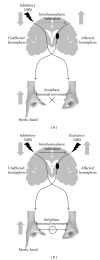Maladaptive plasticity for motor recovery after stroke: mechanisms and approaches
- PMID: 22792492
- PMCID: PMC3391905
- DOI: 10.1155/2012/359728
Maladaptive plasticity for motor recovery after stroke: mechanisms and approaches
Abstract
Many studies in human and animal models have shown that neural plasticity compensates for the loss of motor function after stroke. However, neural plasticity concerning compensatory movement, activated ipsilateral motor projections and competitive interaction after stroke contributes to maladaptive plasticity, which negatively affects motor recovery. Compensatory movement on the less-affected side helps to perform self-sustaining activity but also creates an inappropriate movement pattern and ultimately limits the normal motor pattern. The activated ipsilateral motor projections after stroke are unable to sufficiently support the disruption of the corticospinal motor projections and induce the abnormal movement linked to poor motor ability. The competitive interaction between both hemispheres induces abnormal interhemispheric inhibition that weakens motor function in stroke patients. Moreover, widespread disinhibition increases the risk of competitive interaction between the hand and the proximal arm, which results in an incomplete motor recovery. To minimize this maladaptive plasticity, rehabilitation programs should be selected according to the motor impairment of stroke patients. Noninvasive brain stimulation might also be useful for correcting maladaptive plasticity after stroke. Here, we review the underlying mechanisms of maladaptive plasticity after stroke and propose rehabilitation approaches for appropriate cortical reorganization.
Figures


Similar articles
-
Motor function-related maladaptive plasticity in stroke: a review.NeuroRehabilitation. 2013;32(2):311-6. doi: 10.3233/NRE-130849. NeuroRehabilitation. 2013. PMID: 23535793 Review.
-
Functional MRI correlates of lower limb function in stroke victims with gait impairment.Stroke. 2008 May;39(5):1507-13. doi: 10.1161/STROKEAHA.107.501999. Epub 2008 Mar 13. Stroke. 2008. PMID: 18340092 Free PMC article.
-
Compensatory contribution of the contralateral pyramidal tract after stroke.Front Neurol Neurosci. 2013;32:45-53. doi: 10.1159/000348821. Epub 2013 Jul 8. Front Neurol Neurosci. 2013. PMID: 23859962 Review.
-
Plasticity of the human motor cortex and recovery from stroke.Brain Res Brain Res Rev. 2001 Oct;36(2-3):169-74. doi: 10.1016/s0165-0173(01)00092-3. Brain Res Brain Res Rev. 2001. PMID: 11690613 Review.
-
Motor recovery after stroke: lessons from functional brain imaging.Neurol Res. 2002 Jul;24(5):453-8. doi: 10.1179/016164102101200320. Neurol Res. 2002. PMID: 12117313 Review.
Cited by
-
Motor Cortex and Motor Cortical Interhemispheric Communication in Walking After Stroke: The Roles of Transcranial Magnetic Stimulation and Animal Models in Our Current and Future Understanding.Neurorehabil Neural Repair. 2016 Jan;30(1):94-102. doi: 10.1177/1545968315581418. Epub 2015 Apr 15. Neurorehabil Neural Repair. 2016. PMID: 25878201 Free PMC article. Review.
-
The Translation of Mobile-Exoneuromusculoskeleton-Assisted Wrist-Hand Poststroke Telerehabilitation from Laboratory to Clinical Service.Bioengineering (Basel). 2023 Aug 18;10(8):976. doi: 10.3390/bioengineering10080976. Bioengineering (Basel). 2023. PMID: 37627861 Free PMC article.
-
Enhancing endogenous capacity to repair a stroke-damaged brain: An evolving field for stroke research.Prog Neurobiol. 2018 Apr-May;163-164:5-26. doi: 10.1016/j.pneurobio.2018.01.004. Epub 2018 Feb 21. Prog Neurobiol. 2018. PMID: 29476785 Free PMC article. Review.
-
Opportunities for Guided Multichannel Non-invasive Transcranial Current Stimulation in Poststroke Rehabilitation.Front Neurol. 2016 Feb 24;7:21. doi: 10.3389/fneur.2016.00021. eCollection 2016. Front Neurol. 2016. PMID: 26941708 Free PMC article. Review.
-
Design and test of a Microsoft Kinect-based system for delivering adaptive visual feedback to stroke patients during training of upper limb movement.Med Biol Eng Comput. 2017 Nov;55(11):1927-1935. doi: 10.1007/s11517-017-1640-z. Epub 2017 Mar 25. Med Biol Eng Comput. 2017. PMID: 28343334
References
-
- Chen H, Epstein J, Stern E. Neural plasticity after acquired brain injury: evidence from functional neuroimaging. PM & R. 2010;2(supplement 12):S306–S312. - PubMed
-
- Johnston MV. Plasticity in the developing brain: implications for rehabilitation. Developmental Disabilities Research Reviews. 2009;15(2):94–101. - PubMed
Publication types
MeSH terms
LinkOut - more resources
Full Text Sources
Medical

